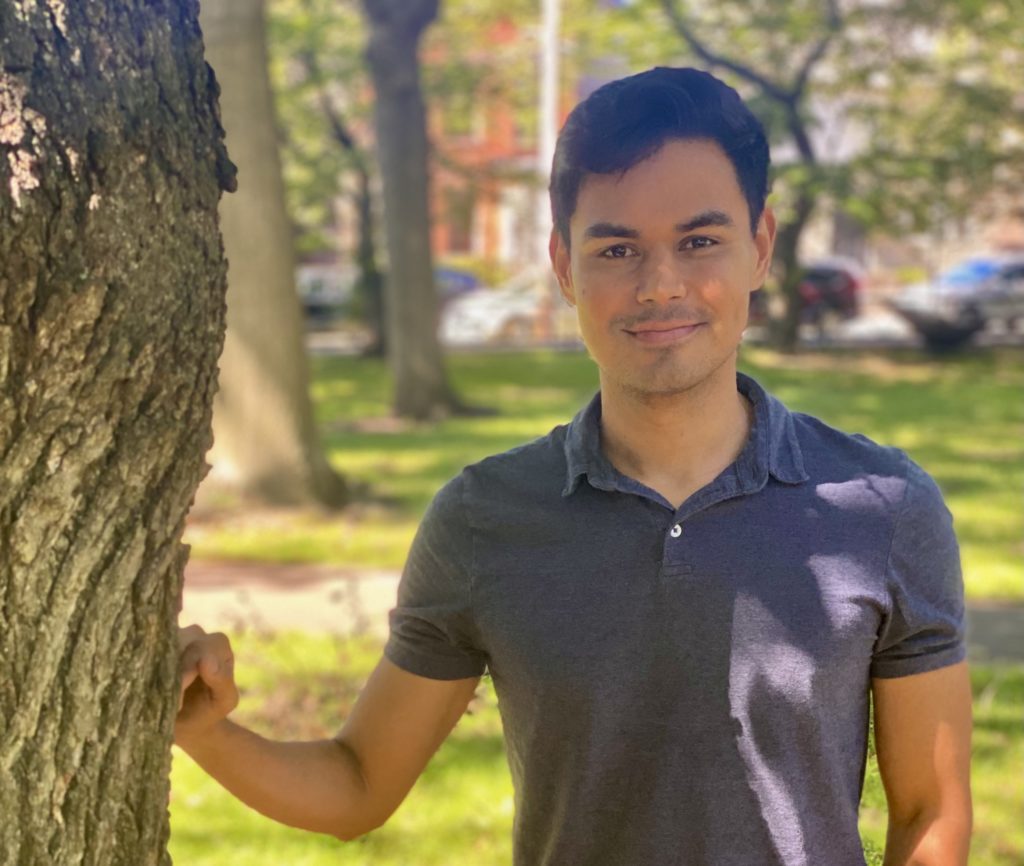Ricardo Gutiérrez’s art reflects ‘indigenous futurism’
Six years ago Ricardo Gutiérrez was in Connecticut for a business meeting at a design firm for which is he was doing graphic work.
But when the young Colombian visual artist stepped off the train in New Haven and saw an intensely blue sky, he says he knew found a new home. And when he discovered the city’s multi-cultural life, he knew he made the right decision.
Gutiérrez has since exhibited here showing his acrylic and oil paintings that he describes loosely as “indigenous futurist,” full of color, nature and graphic designs of his homeland.
An exhibit of his work Urabá: The Promised Land was presented last year in North Haven. Another one just opened at the Armada Brewery in New Haven. (The brewery even commissioned Gutiérrez to design a label for its new brand of beer.) Most recently, he worked with artist Anthony Barroso on a vaccination campaign in Fair Haven.
Gutiérrez’s paintings range from portraiture to the abstract to naturalistic to the surreal. Throughout many of them are bold colors, graphic pops and elements of iconography that reflect his heritage. Often the works reflect his native Colombia: an iridescent Anolis Dracula lizard, a red-orange hibiscus flowers or a rooster set against an explosion of rich hues.
Many of Gutiérrez’ pieces include “molas,” after the ornate textiles of the Indigenous Gunadule people along the Gulf of Urabá. Instead of signing his works, he incorporates a graphic RG hidden in the design.
Gutiérrez, 32, grew up in Apartado a northern city of about 200,000 in the region of Uraba, near the Panamanian border. His father was an artist, so it was no surprise that he naturally showed an interest in the field of art.
Though he says there is a LGBTQ+ scene in Colombia’s larger cities with bars and pride parades, Gutiérrez, who is gay, says there was a lot of bullying when he was growing up. He found that one way to cope was through meditation, a transcendental practice he continues at parks in New Haven and his large rambling Victorian home in which he shares with a roommate in the Edgewood neighborhood. Another way was through the practice of his art, which is also part of his meditative process.
In Colombia, he found his artistic calling at the Fundación Universita. Following graduation, he has worked in photograph production, creating corporate imaging, illustrations, and other design assignments.
Earlier this year Gutiérrez was inspired to create a work of art honoring one of New Haven’s overlooked figures in its history: “King” William Lanson, an 18th Century African American engineer who lived in city and created its famed Long Wharf, advocated for abolition and Black suffrage and was responsible for portions of the Farmington Canal. “I was inspired by his story, and I connected his story with Colombian history, too,” he says.
Though there are not known photographs of Lanson, Gutiérrez was inspired by Dana King’s sculpture on Lanson on the Heritage Trail. The artist created an acrylic-on-canvas painting of a striking visage amid a colorful setting. Gutiérrez donated the painting to the New Haven Museum which exhibited it in its lobby.
Gutiérrez is currently working on new pieces that will reflect his time here and that he expects will be held in spring, 2023.
And where would he like to be in five years?
“Paris,” he says without hesitation, and perhaps with a partner, too, creating more art under more intensely blue skies.
—Frank Rizzo









More Stories
Dancing in Hard Times
Breaking Access Barriers: Connecticut’s Bold New Step Toward Mental Health Parity
Three Gay Guys Talking Cars